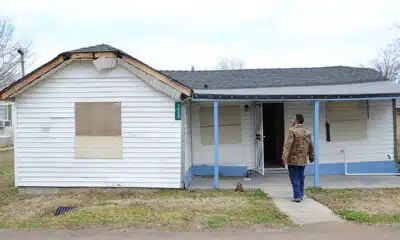News from the South - North Carolina News Feed
Trump funding freeze has NC nonprofits worried about their future
Pause and effect: Threat of Trump funding freeze is making the future tense for North Carolina nonprofits
As President Donald Trump and his appointees rifle through the country’s balance sheets looking for federal spending to slash, many North Carolina nonprofits are operating in a state of financial uncertainty, hoping they’re not the next target of the administration’s cost-cutting ambitions.
While state agencies haven’t reported any major problems accessing the federal funds that trickle down to the more than 3,000 nonprofits that receive government grants, those organizations are still behaving as if it is a possibility.
The strategy for many has been to stay quiet and avoid drawing attention to themselves.
[Subscribe for FREE to Carolina Public Press’ alerts and weekend roundup newsletters]
One week after Trump took office, he issued a memo ordering all federal agencies to temporarily freeze spending on loans and grants. This was necessary, the memo stated, so that officials could review whether the agencies’ payments were aligned with Trump’s previous orders aimed at “financial assistance for foreign aid, nongovernmental organizations, DEI, woke gender ideology and the green new deal.”
The vague memo sent shockwaves through Washington, confusing agencies and angering members of Congress across the political spectrum.
The memo directed that Medicare and Social Security benefits be unaffected by the freeze. But the White House later had to clarify that other programs such as Medicaid and the Supplemental Nutrition Assistance Program (SNAP, colloquially known as food stamps) would also remain untouched.
Two days later, the memo was rescinded altogether.
Lawsuits over the legality of the freeze are ongoing. However, the message to organizations receiving federal money was clear:
Anyone not in lockstep with the Trump agenda risks having their government dollars taken away.
Nonprofit decisions made ‘difficult’
Since 2020, the federal government has funnelled $200 billion into North Carolina through grants and subgrants — funding awarded from an agency to a smaller agency or organization, which is then further distributed to more modest awardees.
The awardees who receive the bulk of federal grants typically fall into one of three categories: state government agencies, universities and hospitals.
None of those types of institutions are at acute risk of being crippled by the revocation of federal funding.
Small nonprofits, however, are worried. Especially those whose values directly contradict the conservative cultural ideology of the Trump administration.

Carolina Public Press reached out to a plethora of state-based nonprofits to ask how they were dealing with financial uncertainty in the wake of the funding freeze. The missions of those organizations ranged from providing affordable childcare to advancing creative arts education to supporting victims of violent crime.
Not many organizations were willing to speak openly — or even anonymously.
“With the climate being rather delicate currently, we are not comfortable commenting on the federal funding and grants situation,” said the communications director of a nonprofit that provides services to the children of migrant workers in North Carolina and several other states.
Other nonprofits who declined to be interviewed or did not respond to CPP’s inquiry at all included the North Carolina Victim Assistance Network, the LGBTQ Center of Durham and Help, Incorporated: Center Against Violence.
Each of those organizations received federal funding last year that originated from the U.S. Department of Justice and was intended to fund programs to support victims of domestic violence and other violent crime.
The strategy for many nonprofits has been to not attract attention in the hopes that they can continue to operate without much trouble.
Other organizations, such as the United Arts Council of Raleigh and Wake County (United Arts), have already seen their federal grants become threatened.
United Arts works closely with Wake County Public Schools to provide students with creative arts experiences, and the organization also awards annual subgrants to local artists to support their projects.
The National Endowment for the Arts recently awarded United Arts a $50,000 grant for distribution to local artists, but that award is now “under review,” United Arts CEO Jenn McEwen announced in February.
“The odds of our NEA grant being rejected in the review process is high,” McEwen said.
In order to offset that potential loss, United Arts urged its supporters for donations.
“Beyond our organization, many of our grantees — small nonprofit arts organizations — are already facing difficult financial decisions,” United Arts public relations manager John Craven told CPP in an email. “Some are scaling back on programs that support their mission but are not central to their signature or flagship offerings as they navigate the uncertainty around federal, state and local funding.
“The combined pressures of this funding uncertainty and economic instability are making it increasingly difficult for these organizations to plan for the future.”
Counting the costs for nonprofits
There are around 10,000 nonprofit organizations in North Carolina. A recent analysis from the nonprofit research center Candid found that 9,946 organizations filed a full 990 tax form at least once between 2021 and 2023.
Of those organizations, just over one third reported receiving at least one government grant in their most recent tax filing.
All in all, North Carolina nonprofits received more than $7 billion from the government through grants.
The Urban Institute, a think tank based in Washington, D.C., further analyzed nonprofit grant data and broke it down at the county level. Researchers found that the organizations in rural regions of the state benefit most from government funding.
The analysis further indicated that nonprofits in rural counties such as Anson, Jones and Northampton would have the biggest financial gap to fill if the Trump administration cost them government grants.
All of the nonprofits in eight North Carolina counties — Anson, Gates, Martin, Montgomery, Perquimans, Person, Sampson and Stokes — would have operating deficits if their government grants were taken away. That’s 46 nonprofits in all.
In 98 of North Carolina’s 100 counties, at least half of the nonprofits would experience an operating deficit if not for their government funding.
As far as subsectors go, the financial uncertainty that comes with the potential loss of government funding is indiscriminate. The Urban Institute found that 75% of education nonprofits, 73% of human services nonprofits and 64% of arts nonprofits in the state would operate in the red without their government grants.
Hospitals and nonprofits related to religion and the environment had the smallest share of organizations reliant on government funding, although that number was still north of 40%.
A ‘fluid’ situation
Although nonprofits are preparing to potentially lose grant money from the Trump funding freeze, that hasn’t been the reality yet.
Two of North Carolina’s most important pass-through funding agencies — the Department of Health and Human Services and the Department of Public Safety — told CPP they’ve made all scheduled payments to subgrant recipients this year.
Both award millions of dollars worth of subgrants to nonprofits across the state each year.
A spokeswoman for the Department of Health and Human Services said that the agency had experienced unexpected delays to some federal payouts, although they were eventually received.
“There have been instances when payments were unexpectedly delayed as well as isolated payments that were under review by federal counterparts for a short period of time,” the spokeswoman said.
The Health and Human Services grants that were put under federal review included money intended to support mental health services and substance-abuse treatments.
At the same time, neither agency denied that they experienced complications related to the federal funding freeze.
“Presently, (the Department of Public Safety) is not having difficulty accessing funding,” a spokeswoman told CPP in an email last week. “The situation is fluid, and we will continue to monitor our ability to drawdown our federal reimbursements and adjust or modify our operations as necessary.”
This article first appeared on Carolina Public Press and is republished here under a Creative Commons license.
The post Trump funding freeze has NC nonprofits worried about their future appeared first on carolinapublicpress.org
News from the South - North Carolina News Feed
Judge will instruct jury to continue deliberations amid juror issue
SUMMARY: Jury deliberations have begun in Sean “Diddy” Combs’ federal sex trafficking trial. Twelve jurors, eight men and four women aged 30 to 74, are deciding his fate after six weeks of testimony from 34 witnesses. Prosecutors allege Combs used his business as a criminal enterprise to exploit and traffic women through power, violence, and fear, urging conviction on five charges including racketeering and sex trafficking. Combs denies all charges, claiming all sexual encounters were consensual, and his defense argues the case is exaggerated. If convicted, Combs faces life in prison. The judge has ordered the jury to continue deliberations despite a juror issue.
The hip-hop mogul is charged with sex trafficking and racketeering conspiracy.
More: https://abc11.com/live-updates/diddy-trial-verdict-live-updates-sean-combs-sex-trafficking-case-nyc-jury-get-monday/16863026/
Download: https://abc11.com/apps/
Like us on Facebook: https://www.facebook.com/ABC11/
Instagram: https://www.instagram.com/abc11_wtvd/
Threads: https://www.threads.net/@abc11_wtvd
TIKTOK: https://www.tiktok.com/@abc11_eyewitnessnews
News from the South - North Carolina News Feed
Tillis criticizes Trump's big tax bill on Senate floor, says he won't run again
SUMMARY: Senator Tom Tillis of North Carolina announced he will not seek re-election, citing a desire to spend more time with family. Tillis broke ranks with Republicans by opposing President Trump’s sweeping domestic policy bill, particularly criticizing Medicaid cuts, which he said would hurt North Carolinians. Trump threatened to back a primary challenger against Tillis after his vote. The Senate aims to pass the bill by July 4, but Democrats delayed debate by forcing a lengthy reading of the 940-page plan. Tillis’s Senate seat is pivotal for Republicans maintaining their majority, sparking a competitive race with several potential candidates from both parties emerging.
Republican Sen. Thom Tillis’ decision to not seek reelection comes after he opposed President Donald Trump’s so-called “Big Beautiful Bill,” which would cut taxes on wages and tips while increasing spending on many of the president’s priorities, including immigration enforcement.
News from the South - North Carolina News Feed
US Senate launches debate on GOP mega-bill, but passage still not assured
SUMMARY: On June 29, 2025, the U.S. Senate began debating Republicans’ massive tax and spending bill, facing complex procedural hurdles including a parliamentarian review and a lengthy amendment process. The bill, dubbed the “big, beautiful bill,” proposes extending the 2017 GOP tax law, cutting Medicaid spending, and restructuring aid programs but is projected to increase deficits by $3.2 trillion over a decade. Senate GOP leaders seek near-unanimous party support amid internal disagreements, including concerns over Medicaid cuts impacting states that expanded the program under Obamacare. Key Republican senators opposed moving forward, threatening the bill’s passage before the Fourth of July deadline.
The post US Senate launches debate on GOP mega-bill, but passage still not assured appeared first on ncnewsline.com
-
News from the South - Tennessee News Feed7 days ago
Thieves take thousands of dollars in equipment from Union County Soccer League
-
Mississippi Today4 days ago
Defendant in auditor’s ‘second largest’ embezzlement case in history goes free
-
News from the South - Texas News Feed6 days ago
Robert Nichols to retire from Texas Senate
-
News from the South - Louisiana News Feed6 days ago
3 lawsuits filed against CVS, Louisiana AG announces
-
News from the South - Florida News Feed6 days ago
DeSantis signs bill into law that ensures public access to Florida beaches | Florida
-
News from the South - Missouri News Feed6 days ago
Residents provide feedback in Kearney Street Corridor redevelopment meeting
-
The Conversation6 days ago
The Vera C. Rubin Observatory will help astronomers investigate dark matter, continuing the legacy of its pioneering namesake
-
News from the South - Alabama News Feed6 days ago
News 5 NOW at 12:30pm | June 24, 2025









































